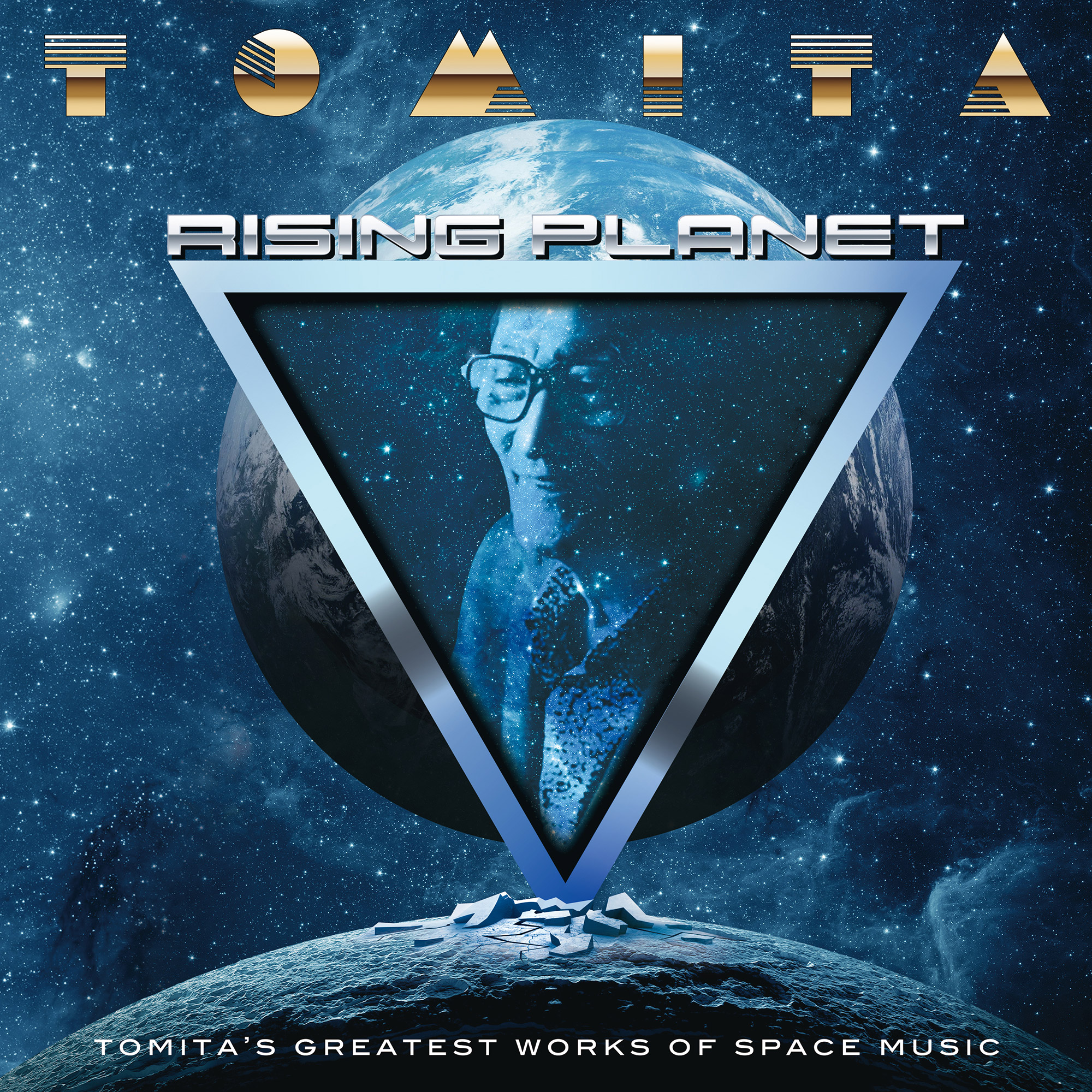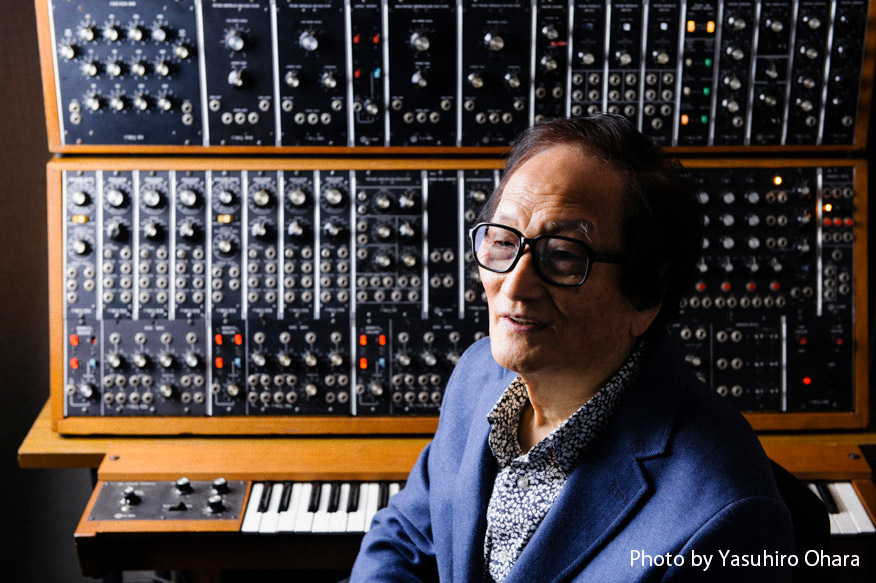
TOMITA
RISING PLANET
Tomita’s Greatest Works of Space Music
Isao Tomita's greatest works from the last five years of his life on the DENON label
This is a project commemorating the fifth anniversary of Isao Tomita's death.Isao Tomita was a world-renowned synthesizer artist and composer who passed away in 2016. Tomita started his career as a composer in his twenties with Nippon Columbia. Then, after pursuing various other careers, he returned to work together with Nippon Columbia again in 2001. In the last five years of his life, he especially devoted himself to the DENON: ISAO TOMITA Project, to completely remake his masterpieces from the 1970s in a form that he had envisioned at the time but could not realize, as well as to add new creations.
This time, as a part of the project, we are releasing a careful selection of the best tracks from the seven albums that were released on the Nippon Columbia DENON label in the last five years of his life, only for streaming platforms.
The main melody of 'Rising of Planet 9', the last melody Tomita left behind, was first heard on the track 'Itokawa and Hayabusa' on 'Planets Ultimate Edition,' the first release of the DENON: ISAO TOMITA Project. This melody also appeared in important parts on subsequent albums, so it could be said to be the trademark phrase of Tomita's later years. With this as a common theme, this album brings together the best of Tomita's creativity, which he imprinted on the discs with an endlessly enterprising spirit during the last five years of his life. What runs through all the tracks collected here is 'space'. This is a collection of the best tracks by a superstar synthesizer artist who continued to embrace and depict his 'longing for space' until the end of his life.
From NIPPON Columbia, their first release using 360 Reality Audio, Sony’s object-based 360 spatial sound technology, comes, “RISING PLANET - TOMITA’S GREATEST WORKS OF SPACE MUSIC” is available streaming now on Amazon Music.
Amazon Music Unlimited : https://music.amazon.co.jp/albums/B099N3XZ29
Known for his lifelong interest in 3D sound, Tomita’s work is optimally experienced in surround sound. 360 Reality Audio, which realizes the 3D sound field with sound spreading 360 degrees, allows you the possibility to hear Tomita's works designed for surround sound as they were meant to be heard, only using your headphones !
What is 360 Reality Audio?
360 Reality Audio is a new immersive experience that uses Sony's object-based 360 Spatial Sound technology. Individual sounds such as vocals, chorus, piano, guitar, bass, and even sounds of the live audience can be placed in a 360 spherical sound field, giving artists and creators a new way to express their creativity. Listeners can be immersed in a field of sound exactly as intended by artists and creators.
Learn more : https://electronics.sony.com/360-reality-audio
TOMITA「MARS from PLANETS」×360 Reality Audio : VR Trailer
“TOMITA「MARS from PLANETS」×360 Reality Audio : VR Trailer” is a collaborative creation fusing the 360 Reality Audio sound materials of “PLANETS - Mars”–which propelled Tomita into international stardom–and 360 VR videos directed by Naohiro Ukawa, an artist known for working closely with Tomita in his later years.
From the launch of the pobe, it reached Mars, landed on the ground surface, and then launched back to earth again.
The 3DCG data of Mars was based on the actual satellite data provided by amulapo and high-resolution 360-degree panoramic images of the Mars landing site taken by NASA’s rover Curiosity and Perseverance. Under Ukawa’s direction, this information was converted to VR 360 images. Tomita’s surround sound intermingles with the VR 360 video, allowing you to experience the XR sensation created by the outer dimensional fusion of reality and fantasy.
TOMITA「MARS from PLANETS」×360 Reality Audio : VR Trailer
The sound of tomita has been part of me for many years, I've used it in many different scenarios especially sleeping, the music of tomita has shown me colorful visions and lucid dreams. These classical compositions are redefined and reimagined with such amazing sonics that, to me, are some of the most interesting sounds I've ever heard.
Tomita was ahead of his time and I'm so glad that there's a new generation of listeners interested in his magic.
Flying Lotus
*Streaming will start on Spotify, Apple Music, etc. from July 21.
- Mars
- Itokawa and Hayabusa
- Whistle and Chime - The Art of Sound Creation
- 1ere Arabesque
- Clair de Lune
- Nuages
- Rising Sun
- The Sea Named "Solaris"
- The Unanswered Question
- Night on the Galactic Railroad
- Rising of the Planet 9
"RISING PLANET" Tomita's Greatest Works of Space Music Digest
【Track List】
1. Mars
2. Itokawa and Hayabusa
From 'PLANETS Ultimate Edition' released in June 2011.
In the 1970s, Isao Tomita stunned the world with a series of innovative albums in which he 'recreated orchestral music with electronic sounds'. In 2011, Tomita himself remade the entire work of 'PLANETS' (released in 1977), which stands out for its overwhelming creativity, by using new equipment. The first track, 'Mars' (Track 1), starts with the sound of communication with the universe as in the old version, but then the bass is greatly enhanced. The surround sound effects have also been completely recreated, and the evolution is truly worthy of the name 'complete version'.
The news of JAXA's (Japan Aerospace Exploration Agency) asteroid probe Hayabusa's exploration of the asteroid Itokawa and its return to Earth on June 13, 2010, was a hot topic both in Japan and abroad. Tomita, who had a personal relationship with Dr. Hideo Itokawa, the father of Japanese space engineering who named the asteroid Itokawa, was greatly impressed by this news and added a new song 'Itokawa and Hayabusa' (Track 2) in 'PLANETS', as a requiem in memory of Dr. Itokawa. With electronic sounds reminiscent of the probe Hayabusa being towed through the lonely vastness of space, the tune was played by the synthesizer as a mourning melody, which also often appeared as a trademark phrase to color Tomita's works in his later years.
3. Whistle and Chime - The Art of Sound Creation
4. 1ere Arabesque
5. Clair de Lune
6. Nuages
From 'CLAIR DE LUNE Ultimate Edition' released in June 2012.
Shocked by Walter Carlos' (currently Wendy Carlos) 'Switched-On Bach', Tomita imported a Moog synthesizer in 1971, built an electronic music studio at home, and began his career as a synthesizer musician. His first work, 'CLAIR DE LUNE', is a synth piece based on Debussy's piano pieces, and was released on RCA Records in 1974. It reached No. 2 on the Billboard Classical Charts and was the first Japanese musician to be nominated for a Grammy Award. This is a novel and shocking work that overturned the conventional image of electronic music as inorganic sound, and made the world aware of the possibilities of synth music. The Ultimate Edition of the piece has been remade using the latest equipment, and the sound quality is dramatically clearer than the original version.
'Whistle and Chime - The Art of Sound Creation' (Track 3) is a unique track that reveals the secrets of Tomita Sound's production. You can catch glimpses of pink noise eventually becoming whistling through a filter and pure tones overlapping at four-degree intervals transforming into the sound of bells through time envelope processing, which eventually lead to '1ere Arabesque'.
The title track 'Clair de Lune' (Track 4), which has been called one of Tomita's best synthesizer works, depicts an overwhelming poetic world that may surpass Debussy's original work with delicate and colorful electronic sounds.
'Nuages' (Debussy's Nocturnes No.1/Track 6), newly made for the 'Ultimate Edition', was created by superimposing Tomita's impression of the mysterious but beautiful 'earthquake clouds' he witnessed during the Mikawa Earthquake in 1945 onto the image of the Pure Land.
7. Rising Sun
From 'PLANET ZERO FREEDOMMUNE 0 <ZERO> session with Dawn Chorus' released in November 2011
In the summer of 2011, the announcement of the outdoor event FREEDOMMUNE 0 <ZERO>, scheduled to have Jeff Mills and other spectacular performers, made a big splash. It was a phantom event that had to be canceled due to unexpectedly bad weather conditions, despite the fact that the more than 10,000 tickets instantly sold out. A special edition of Isao Tomita's 'PLANETS' was planned to be performed as the main event. This special edition features the glorious sound of newly added trumpets at sunrise, foreshadowing the 'dawn chorus' that can only be received at dawn from radio waves emitted from sunspots. The album 'PLANET ZERO' was immediately released in order to deliver this fantastic work to as many people as possible, since it would have been a shame to put this incomparable work on hold. The track that was to be performed on the day of the festival has been mastered to be released on disc. This work is based on 'PLANETS Ultimate Edition', and is partially rewritten as a new requiem, and recomposed with the addition of 'dawn chorus' and trumpets. 'Rising Sun' (Track 7) is a track that was intended to be played precisely at dawn, and Tomita aimed to collaborate with the universe by receiving the 'dawn chorus' that occurs only at dawn live and layering it with the piece. The melody of 'Itokawa and Hayabusa' and the famous melody of 'Jupiter' are accompanied by the heroic trumpet sound of trumpeter Kazuya Homma, whom Tomita trusted completely in his later years. As originally conceived, this project was staged as the headliner at dawn at the FREEDOMMUNE 0 <ZERO> at Makuhari Messe, which was successfully held in 2013, and drew a great response.
8. The Sea Named "Solaris"
From 'PICTURES AT AN EXHIBITION Ultimate Edition' released in March 2014
The complete version of Isao Tomita's 'PICTURES AT AN EXHIBITION', released in 1974 on RCA in the U.S., has the same greatly enhanced sound quality and sound field expression as the other complete versions of his works, and also includes a bonus track of a part of the fantastic 'Scheherazade', which was only aired on NHK-FM in the 1970s. Tomita himself recalled, "It was a difficult piece of music," and the production of the original recording of this fantastic piece was abandoned in the middle of the project, so he came up with the idea of connecting 'COSMOS' to 'The Sea Named "Solaris"' to create a composition that takes the listener from the Arabian Sea to the great ocean of space. 'The Sea Named "Solaris"' (Track 8) is inspired by Tarkovsky's 'Solaris' and combines and develops a melody by J.S. Bach.
9. The Unanswered Question
From 'SPACE FANTASY' released in March 2015
'SPACE FANTASY' is an album based on 'COSMOS' released in 1978, with excerpts from 'FIREBIRD' (1976) and 'Bermuda Triangle' (1978), newly composed by Isao Tomita himself, and was released with 4.0 channel surround sound. 'The Unanswered Question' (Track 9) was an important work for Tomita until his later years. This piece was newly incorporated and performed in the live performance of 'PLANET ZERO' at the time of FREEDOMMUNE 0 <ZERO> in 2013, and was also originally conceived to be used in the performance of 'Doctor Coppelius’ mentioned below. While maintaining the haunting atmosphere of the original song by Ives, Tomita's spacious electronic sound colors are added to it.
10. Night on the Galactic Railroad
From 'SYMPHONY IHATOV' released in January 2013
One of the most prominent aspects of Tomita's works in his later years was his collaboration with the world-famous virtual singer Hatsune Miku.
Even at the age of 80, Tomita was still actively engaged in creative activities, and this 'SYMPHONY IHATOV' is a major work of his from that time. During the war, Tomita, a fifth grader in elementary school, picked up Kenji Miyazawa's works for the first time. Tomita, a young boy, was immediately fascinated by the colorful world of the works he encountered in the midst of the monochrome world of reality. After that, his admiration for Miyazawa continued, and his long-held desire to someday express his colorful world in his own work came to fruition in this 'SYMPHONY IHATOV'.
A large orchestra and chorus with a total of about 300 people depict the world of Kenji Miyazawa's otherworldly works and the powerful land of the Tohoku region that nurtured them. The virtual singer Hatsune Miku suddenly appears in a chaotic space where heroic and exuberant melodies are intertwined with layers of colorful sounds. Tomita, the founder of Japanese electronic music, has long dreamed of a 'machine that sings'. Miku, who became popular all over the world, embodied the dream that Tomita had entrusted to her when her unique voice descended upon the orchestral sound. 'Night on the Galactic Railroad' (Track 10) is the climax of the piece, with Miku singing an impressive melody, followed by a quotation of the famous melody from Rachmaninoff's Symphony No. 2. Then, with Tomita's colorful orchestral arrangement, the piece unfolds into what could be called a flight into space.
11. Rising of the Planet 9
From the March 2017 RELEASE of 'Doctor Coppelius'
Isao Tomita passed away on May 5, 2016, at the age of 84. There was a work that he had been dreaming of performing and creating until the moment of his death. It was called 'Doctor Coppelius'. Tomita left the draft of most of the story and the music concept behind. A large-scale story full of 'dreams and hopes for the universe', which he had been pursuing for many years, unfolds with orchestra, synthesizers, and ballet. This symphony with ballet was originally conceived by Tomita himself in the 1980s as a development of 'Itokawa and Hayabusa'. The work was handed over to the project members who had been working with him before his death, and the premiere took place on November 11 and 12, 2016. After the performance, the curtain closed with loud cheers and unending applause. The climax of this piece is 'Rising of the Planet 9' (Track 11), where Tomita's electronic sounds, orchestral sounds, and Hatsune Miku's singing become a trinity. The melody of 'Itokawa and Hayabusa', the last melody he composed, is played by the orchestra, and Hatsune Miku sings the last part of the song, which made a moving end to the piece.
'Doctor Coppelius' is the final form of the world-famous artist Isao Tomita's last will and also his testament to the future. It is as if the music of a ‘Rising Sun' itself is imprinted on the image of Isao Tomita himself, whose soul may still be alive in the outer space that he had been longing for.

Isao Tomita (1932-2016)
While still a student at Keio University, Tomita began to work as a composer in a variety of fields. In 1974 he released 'Clair de lune' using synthesizers, which reached No. 1 on Billboard magazine, and became the first Japanese to be nominated for a Grammy Award. Since then, he has released a string of albums that have become unprecedented hits around the world. Since then, he has composed music for numerous NHK Taiga dramas and films directed by Yoji Yamada. In 2011, the 'ISAO TOMITA PROJECT' was launched. He continuously released 'Solaris', 'Clair de lune', and other past masterpieces on Nippon Columbia as remakes and surround sound versions. He was awarded the Asahi Prize in January 2011. In November, the world premiere of 'SYMPHONY IHATOV', based on the world of Kenji Miyazawa's works and featuring Hatsune Miku as the soloist, was a big hit. In 2014, he was invited to speak at the Red Bull Music Academy Tokyo 2014 in front of young music creators from around the world, which became a worldwide sensation. In May 2015, 'SYMPHONY IHATOV' was performed in Beijing, China. On May 5, 2016, he passed away from chronic heart failure at the age of 84.
The space ballet symphony 'Doctor Coppelius', which he had been working on until an hour before his death, was performed in Tokyo as a memorial performance and became a big hit.




